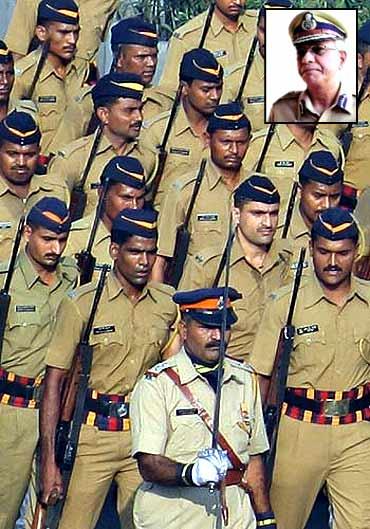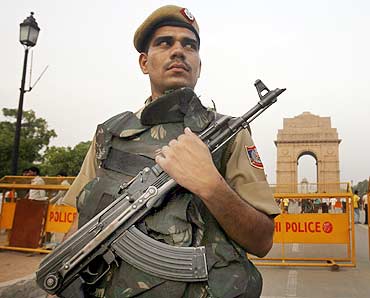 | « Back to article | Print this article |
'Maharashtra has enough force to tackle Naxal menace'
Indian Police Service officer of 1976 batch, K Subrahmanyam, recently took charge as the chief of Maharashtra police. He spoke with rediff.com's Toral Varia on his priorities and future course of action.
You recently took charge of the state police. Over the past ten days you have been receiving briefs from various departments and taking stalk of the situation. What are your priorities in the days ahead?
Well, in a sense the task is already cut out for anyone who is sits on this chair. I am also going to try to strengthen the force in terms of policing, tackling the naxal menace, maintain law and order and streamlining and expediting the process of modernisation.
Procurement of equipment and other material for police force is also a priority. For various reasons -- lack of understanding, lack of coordination there was a delay. Of late we have been procuring very sophisticated equipment, so specifications have to be defined very accurately in the tender.
You float a tender, you make an agreement and no side can deviate from it. So from that point of view the specifications and the data collection perhaps have taken a lot of time. There are various other reasons as well due to which procurement had taken a backseat.
As a result, funds that came in were returned, while some funds lapsed. In one particular case, money was drawn, payments were made but the product was not delivered and the reconciliation remains to be done.
All this needs to be sorted out. I have already started the process. It will take a few weeks to be completely sorted out because it takes some time to fight the system.
What is your main concern as far as general law and order situation is concerned vis-a-vis naxalism in southern Maharashtra?
Naxalism has spread in the southern part of Maharashtra like Gadhchiroli and Gondia, which is a major concern. I have just returned from a visit to naxal-affected areas, where I interacted with villagers residing in extremely remote villages. It's pretty evident why it is said that Naxalism is India's biggest internal security threat.
Having said that I must point out that there is enough manpower and force to tackle the naxal menace. There is enough will in the officers and personnel on the ground too – all they need is motivation from time to time. They need a push, which I am trying to give. I am confident that they will do the job very well. We already have five companies of CRPF (Central Reserve Police Force), 10 battalions of State Reserve Police Force, we have our own anti-naxal force C-60, the Special Action Groups – we are prepared to fight.
When I interacted with my officers I told them that I need action here, I expect you to take action and show me the results. I am confident that they will do it and in the process, there could be casualties on either side, but we are prepared.
Click NEXT to read further...
'Only local officers, informers can give real-time inputs'
What about intelligence inputs?
We need to get information. We cannot be sitting in offices and expect to get information. We need to get deep into the villages and get the information from the ground. That is why I visited one of the most remote villages to get a firsthand sense of the situation.
When I was meeting my officers on the ground, I could sense that they were a little critical of the inputs coming in from the two main intelligence agencies – the Intelligence Bureau and the State Intelligence Department. But I explained to them why it should not be critical. I explained to them saying, for example, that there are 130 inputs that come in, out of which only 40 operations have been worked out. I tried to explain to my officers that they should not consider all 130 inputs as 'operational inputs'.
It's not possible that all the inputs will be specific and lead to operations. These inputs show a 'trend' of how far and wide the Naxals have spread. They should not consider each input with the view of an operational utility. If any input leads to a successful operation then well and good, if not then the input should not be trashed, because inputs are indicative of trends, so it is still needed for analysis.
Also, they need to concentrate on real-time inputs. Outside the Intelligence Bureau and the State Intelligence Department no one can give real-time inputs. That can happen only through the help of local officers and the informers that they have developed locally. For example, the C60 fellows are all locals. They go inside the village, talk to their own people in their own language and are able to get some really good and concrete information. So the point is, the best penetrations can be done by the local people only and in a way they are trying to do it as well.
From time to time the ability of Maharashtra's Anti Terrorism Sqaud has been questioned. For a long time now ATS hasn't been successfully able to crack a case or secure a good conviction. What really is the update on the 13/7 (Mumbai blasts) case?
We need to understand that the job of the ATS is not easy. For example, take the CCTV footage of Opera House – the kind of confusion and chaos that prevails in those areas, it makes it extremely difficult to distinguish and identify people.
Despite all this, let me tell you, there is a significant development in the 13/7 blasts case. The bombers have been identified. But it doesn't end there. It's an extremely difficult case and the ATS officers have been working very hard on it. Yes, there are other factors like the financial trails that need to be established with concrete evidence which can sustain the scrutiny of a legal process. And the officers are working towards it. A lot of dots need to be joined. I can say with confidence that they have got strong leads. Standards of proof demanded by the courts are also very high, and perhaps rightly so.
Click NEXT to read further...
'Well-oiled police machinery can reduce risk considerably'
How do you plan to improve the general law and order of the state on the whole?
Law and order is related to both crime and politics. Law and order could also be a result of political turmoil and there is little control over that. In such situations we need to go with the wind and change our strategies according to it, and deal with it. One way is also to try and prevent situation by negotiations.
As far as crime related law and order situations are concerned, it's entirely our responsibility. For that we need to ensure that proper policing patterns, standard operating procedures etc. are followed. For example, dacoity, chain snatchings, robberies need to be controlled.
Intelligence agencies are not just sitting ideal. There are several attempts or inputs that have been worked out which has foiled several bids that have not made it to the news. And it should still be the same, because if it makes news then it would not have been averted. Once it is put under the wraps, the situation is under control.
Undoubtedly terrorism is one of the main concerns today. Can we ever say that we are prepared?
Not only Maharashtra but every state is vulnerable. We cannot take any chances and we are in a constant state of high alert and we need to be like that. If all the systems of intelligence input, law and order etc are well-oiled then we can reduce the risk considerably. Trouble makers need to be lucky just once, but we have to be lucky always. Hence the high levels of alertness.
For instance, it is easy to secure an area like the airport. It's easy because it can be isolated and then secured. But the same is not possible in an area like a railway station. In my personal opinion, the railway stations have a major potential for a security risk today. So while we cannot secure a place completely where the flow of people is so high, we can certainly reduce the risks.
Do you really think that installation of CCTV cameras across the city of Mumbai is a practical solution? For example you see the London riots footage – although CCTVs were in place, the perpetrators were all masked and hence are still scot free.
At least it has come on the CCTV cameras that they were masked. They can at least be identified by other features. But the point really is what could be good for London, may not be good for Mumbai. So personally, I feel that it just simply doesn't work like this.
London streets are not like Mumbai streets, we don't have vehicular identities registered, leave alone the identity of a person. Moreover, CCTV cameras are useful mostly for post-event analysis or investigations. They can be helpful in prevention only if the output is monitored 24/7, a facility which is not available with us yet. At max as of now the best possible use of CCTV would be for traffic management and post-incident analysis.


